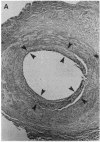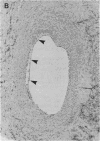Abstract
The role of recurrent platelet aggregation in the development of neointimal proliferation of coronary arteries was explored in this study, and the hypothesis was evaluated that recurrent platelet aggregation and the consequent frequency and severity of cyclic coronary blood flow variations are important pathophysiologic factors in the subsequent development of neointimal proliferation. In 24 chronically instrumented dogs, variable degrees of coronary artery neointimal proliferation were observed 3 weeks after mechanical injury of the arterial endothelium and the placement of an external coronary artery constrictor. The severity of neointimal proliferation at 21 days was closely related to the frequency and severity of cyclic coronary blood flow variations during the initial 7 days after instrumentation of the animals, itself a manifestation of recurrent platelet aggregation and dislodgement. Pharmacological therapy with a dual thromboxane A2 synthetase inhibitor and receptor antagonist and with a serotonin S2 receptor antagonist frequently was successful in abolishing cyclic blood flow variations and in retarding neointimal proliferation.
Full text
PDF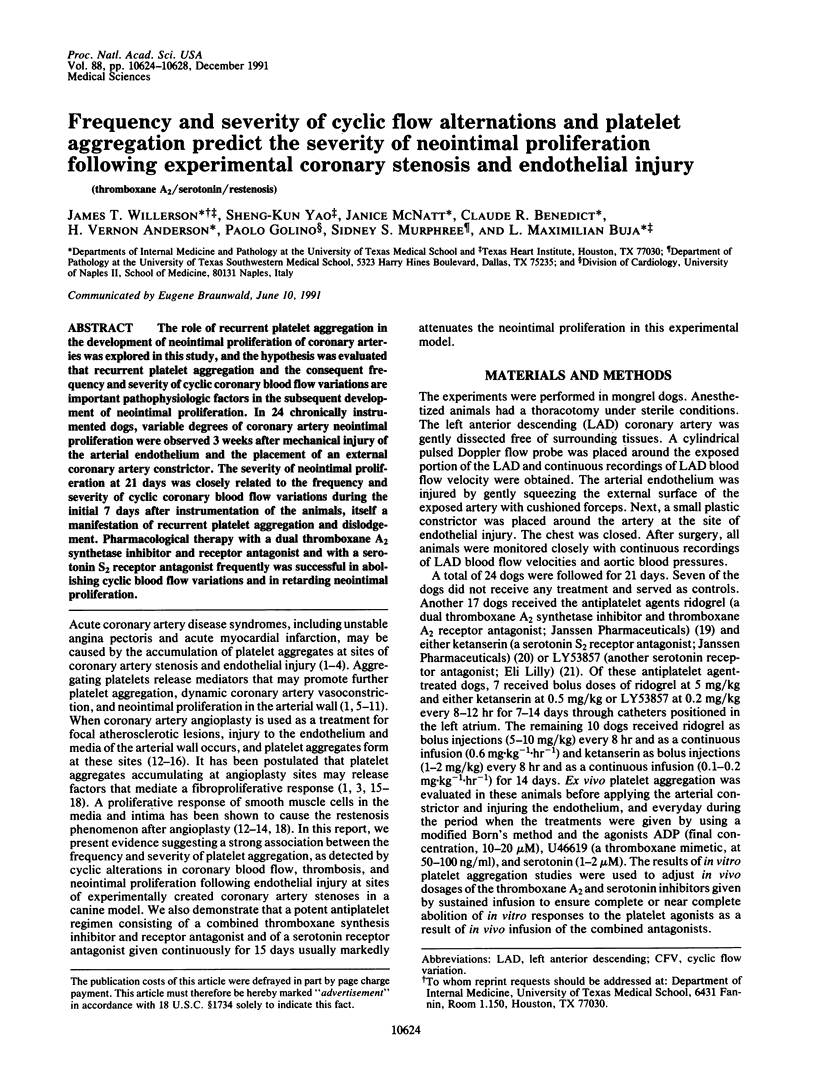
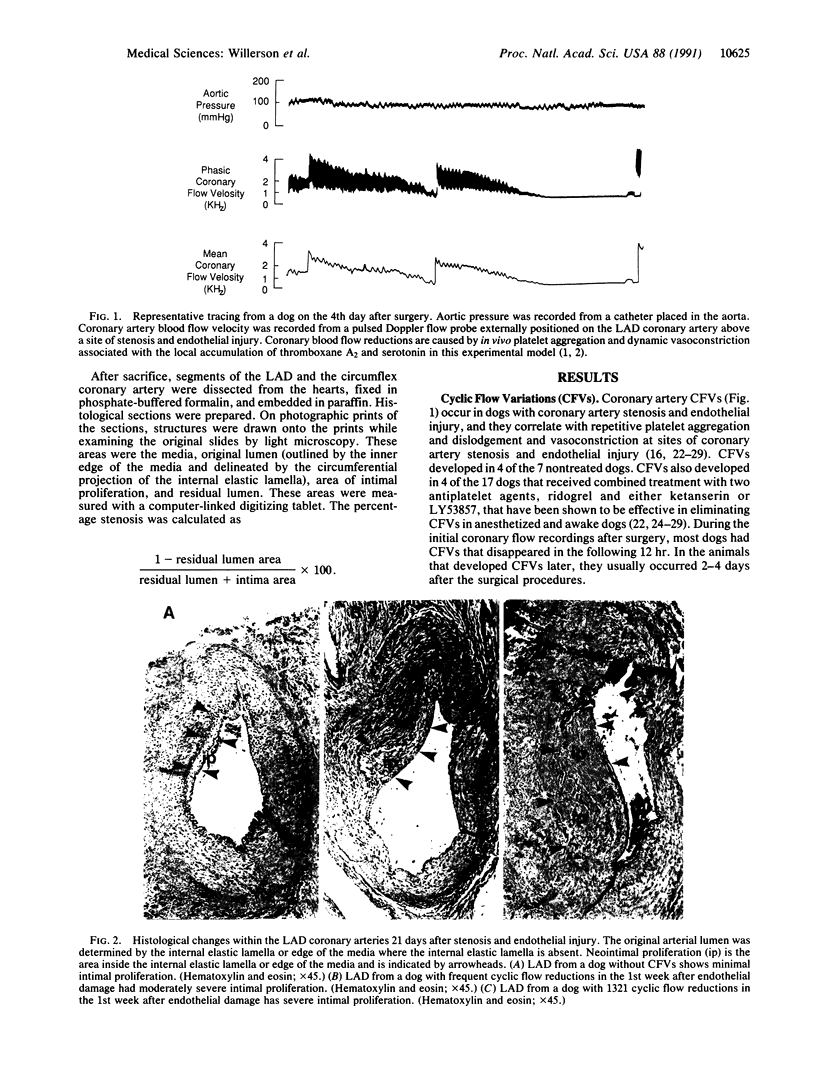
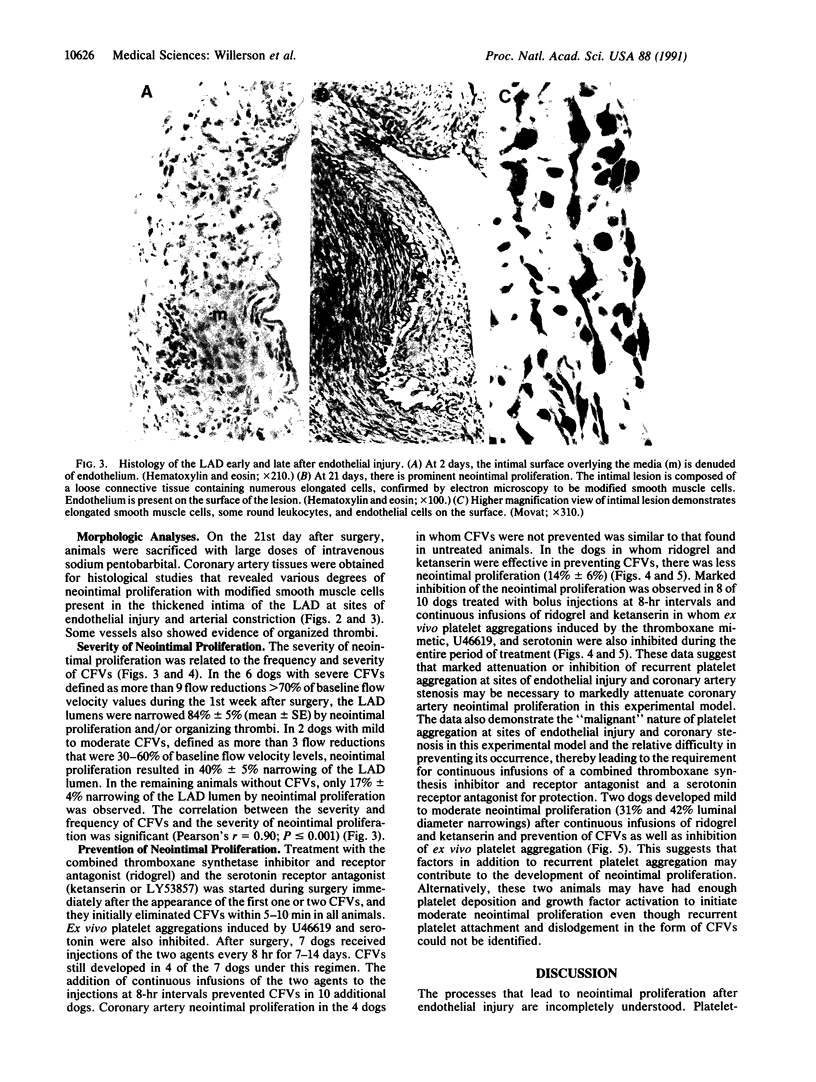
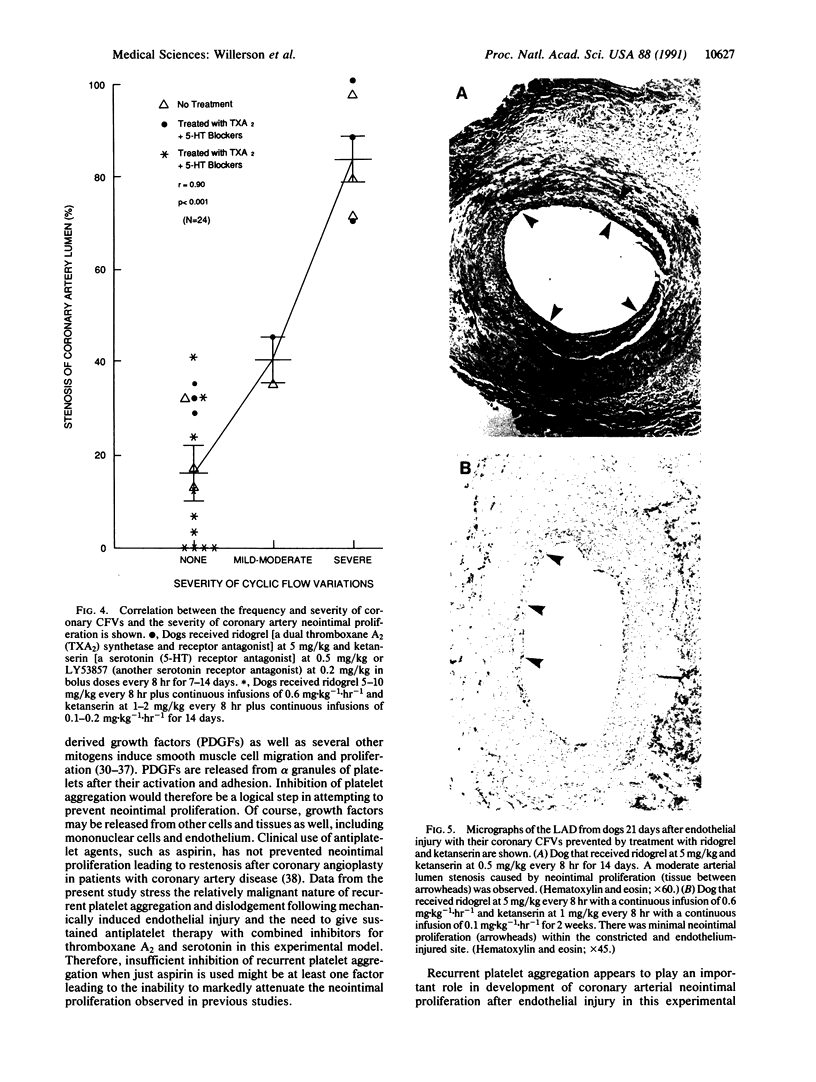
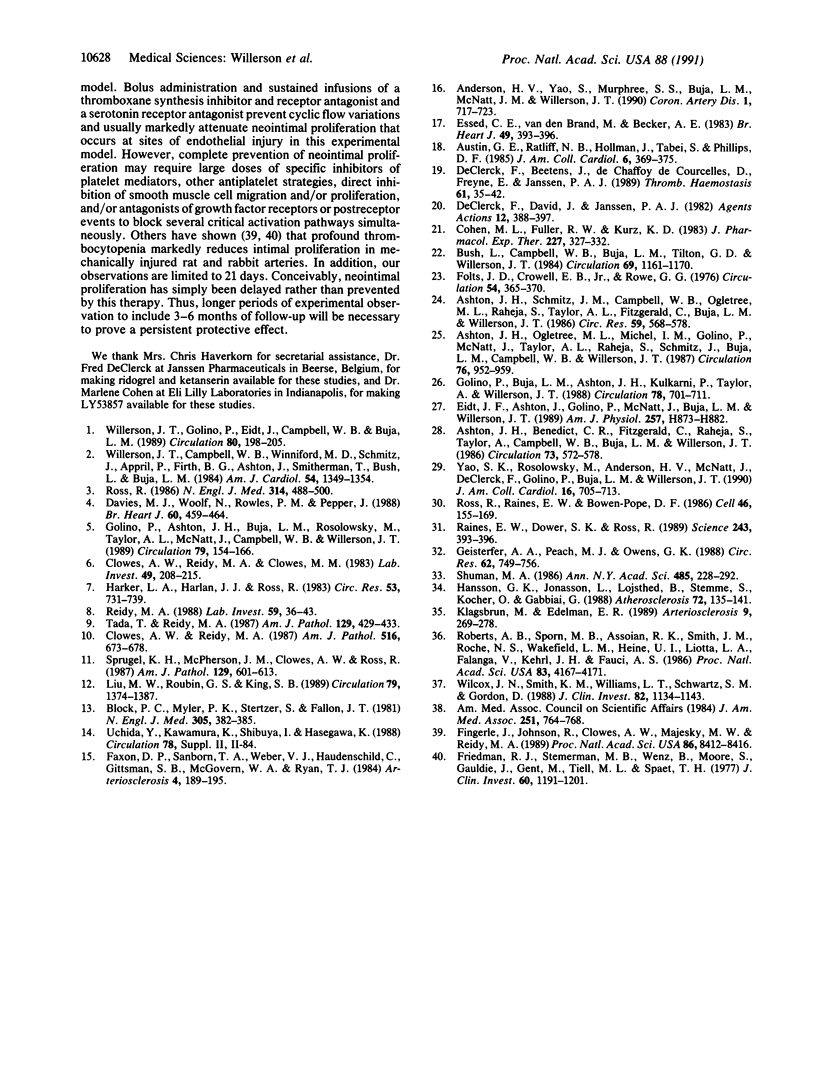
Images in this article
Selected References
These references are in PubMed. This may not be the complete list of references from this article.
- Ashton J. H., Benedict C. R., Fitzgerald C., Raheja S., Taylor A., Campbell W. B., Buja L. M., Willerson J. T. Serotonin as a mediator of cyclic flow variations in stenosed canine coronary arteries. Circulation. 1986 Mar;73(3):572–578. doi: 10.1161/01.cir.73.3.572. [DOI] [PubMed] [Google Scholar]
- Ashton J. H., Ogletree M. L., Michel I. M., Golino P., McNatt J. M., Taylor A. L., Raheja S., Schmitz J., Buja L. M., Campbell W. B. Cooperative mediation by serotonin S2 and thromboxane A2/prostaglandin H2 receptor activation of cyclic flow variations in dogs with severe coronary artery stenoses. Circulation. 1987 Oct;76(4):952–959. doi: 10.1161/01.cir.76.4.952. [DOI] [PubMed] [Google Scholar]
- Ashton J. H., Schmitz J. M., Campbell W. B., Ogletree M. L., Raheja S., Taylor A. L., Fitzgerald C., Buja L. M., Willerson J. T. Inhibition of cyclic flow variations in stenosed canine coronary arteries by thromboxane A2/prostaglandin H2 receptor antagonists. Circ Res. 1986 Nov;59(5):568–578. doi: 10.1161/01.res.59.5.568. [DOI] [PubMed] [Google Scholar]
- Austin G. E., Ratliff N. B., Hollman J., Tabei S., Phillips D. F. Intimal proliferation of smooth muscle cells as an explanation for recurrent coronary artery stenosis after percutaneous transluminal coronary angioplasty. J Am Coll Cardiol. 1985 Aug;6(2):369–375. doi: 10.1016/s0735-1097(85)80174-1. [DOI] [PubMed] [Google Scholar]
- Block P. C., Myler R. K., Stertzer S., Fallon J. T. Morphology after transluminal angioplasty in human beings. N Engl J Med. 1981 Aug 13;305(7):382–385. doi: 10.1056/NEJM198108133050706. [DOI] [PubMed] [Google Scholar]
- Bush L. R., Campbell W. B., Buja L. M., Tilton G. D., Willerson J. T. Effects of the selective thromboxane synthetase inhibitor dazoxiben on variations in cyclic blood flow in stenosed canine coronary arteries. Circulation. 1984 Jun;69(6):1161–1170. doi: 10.1161/01.cir.69.6.1161. [DOI] [PubMed] [Google Scholar]
- Clowes A. W., Reidy M. A., Clowes M. M. Mechanisms of stenosis after arterial injury. Lab Invest. 1983 Aug;49(2):208–215. [PubMed] [Google Scholar]
- Clowes A. W., Reidy M. A. Mechanisms of arterial graft failure: the role of cellular proliferation. Ann N Y Acad Sci. 1987;516:673–678. doi: 10.1111/j.1749-6632.1987.tb33084.x. [DOI] [PubMed] [Google Scholar]
- Cohen M. L., Fuller R. W., Kurz K. D. LY53857, a selective and potent serotonergic (5-HT2) receptor antagonist, does not lower blood pressure in the spontaneously hypertensive rat. J Pharmacol Exp Ther. 1983 Nov;227(2):327–332. [PubMed] [Google Scholar]
- Davies M. J., Woolf N., Rowles P. M., Pepper J. Morphology of the endothelium over atherosclerotic plaques in human coronary arteries. Br Heart J. 1988 Dec;60(6):459–464. doi: 10.1136/hrt.60.6.459. [DOI] [PMC free article] [PubMed] [Google Scholar]
- De Clerck F., Beetens J., de Chaffoy de Courcelles D., Freyne E., Janssen P. A. R 68 070: thromboxane A2 synthetase inhibition and thromboxane A2/prostaglandin endoperoxide receptor blockade combined in one molecule--I. Biochemical profile in vitro. Thromb Haemost. 1989 Feb 28;61(1):35–42. [PubMed] [Google Scholar]
- Eidt J. F., Ashton J., Golino P., McNatt J., Buja L. M., Willerson J. T. Thromboxane A2 and serotonin mediate coronary blood flow reductions in unsedated dogs. Am J Physiol. 1989 Sep;257(3 Pt 2):H873–H882. doi: 10.1152/ajpheart.1989.257.3.H873. [DOI] [PubMed] [Google Scholar]
- Essed C. E., Van den Brand M., Becker A. E. Transluminal coronary angioplasty and early restenosis. Fibrocellular occlusion after wall laceration. Br Heart J. 1983 Apr;49(4):393–396. doi: 10.1136/hrt.49.4.393. [DOI] [PMC free article] [PubMed] [Google Scholar]
- Faxon D. P., Sanborn T. A., Weber V. J., Haudenschild C., Gottsman S. B., McGovern W. A., Ryan T. J. Restenosis following transluminal angioplasty in experimental atherosclerosis. Arteriosclerosis. 1984 May-Jun;4(3):189–195. doi: 10.1161/01.atv.4.3.189. [DOI] [PubMed] [Google Scholar]
- Fingerle J., Johnson R., Clowes A. W., Majesky M. W., Reidy M. A. Role of platelets in smooth muscle cell proliferation and migration after vascular injury in rat carotid artery. Proc Natl Acad Sci U S A. 1989 Nov;86(21):8412–8416. doi: 10.1073/pnas.86.21.8412. [DOI] [PMC free article] [PubMed] [Google Scholar]
- Folts J. D., Crowell E. B., Jr, Rowe G. G. Platelet aggregation in partially obstructed vessels and its elimination with aspirin. Circulation. 1976 Sep;54(3):365–370. doi: 10.1161/01.cir.54.3.365. [DOI] [PubMed] [Google Scholar]
- Friedman R. J., Stemerman M. B., Wenz B., Moore S., Gauldie J., Gent M., Tiell M. L., Spaet H. The effect of thrombocytopenia on experimental arteriosclerotic lesion formation in rabbits. Smooth muscle cell proliferation and re-endothelialization. J Clin Invest. 1977 Nov;60(5):1191–1201. doi: 10.1172/JCI108872. [DOI] [PMC free article] [PubMed] [Google Scholar]
- Geisterfer A. A., Peach M. J., Owens G. K. Angiotensin II induces hypertrophy, not hyperplasia, of cultured rat aortic smooth muscle cells. Circ Res. 1988 Apr;62(4):749–756. doi: 10.1161/01.res.62.4.749. [DOI] [PubMed] [Google Scholar]
- Golino P., Ashton J. H., Buja L. M., Rosolowsky M., Taylor A. L., McNatt J., Campbell W. B., Willerson J. T. Local platelet activation causes vasoconstriction of large epicardial canine coronary arteries in vivo. Thromboxane A2 and serotonin are possible mediators. Circulation. 1989 Jan;79(1):154–166. doi: 10.1161/01.cir.79.1.154. [DOI] [PubMed] [Google Scholar]
- Golino P., Buja L. M., Ashton J. H., Kulkarni P., Taylor A., Willerson J. T. Effect of thromboxane and serotonin receptor antagonists on intracoronary platelet deposition in dogs with experimentally stenosed coronary arteries. Circulation. 1988 Sep;78(3):701–711. doi: 10.1161/01.cir.78.3.701. [DOI] [PubMed] [Google Scholar]
- Hansson G. K., Jonasson L., Lojsthed B., Stemme S., Kocher O., Gabbiani G. Localization of T lymphocytes and macrophages in fibrous and complicated human atherosclerotic plaques. Atherosclerosis. 1988 Aug;72(2-3):135–141. doi: 10.1016/0021-9150(88)90074-3. [DOI] [PubMed] [Google Scholar]
- Harker L. A., Harlan J. M., Ross R. Effect of sulfinpyrazone on homocysteine-induced endothelial injury and arteriosclerosis in baboons. Circ Res. 1983 Dec;53(6):731–739. doi: 10.1161/01.res.53.6.731. [DOI] [PubMed] [Google Scholar]
- Klagsbrun M., Edelman E. R. Biological and biochemical properties of fibroblast growth factors. Implications for the pathogenesis of atherosclerosis. Arteriosclerosis. 1989 May-Jun;9(3):269–278. doi: 10.1161/01.atv.9.3.269. [DOI] [PubMed] [Google Scholar]
- Liu M. W., Roubin G. S., King S. B., 3rd Restenosis after coronary angioplasty. Potential biologic determinants and role of intimal hyperplasia. Circulation. 1989 Jun;79(6):1374–1387. doi: 10.1161/01.cir.79.6.1374. [DOI] [PubMed] [Google Scholar]
- Reidy M. A. Endothelial regeneration. VIII. Interaction of smooth muscle cells with endothelial regrowth. Lab Invest. 1988 Jul;59(1):36–43. [PubMed] [Google Scholar]
- Roberts A. B., Sporn M. B., Assoian R. K., Smith J. M., Roche N. S., Wakefield L. M., Heine U. I., Liotta L. A., Falanga V., Kehrl J. H. Transforming growth factor type beta: rapid induction of fibrosis and angiogenesis in vivo and stimulation of collagen formation in vitro. Proc Natl Acad Sci U S A. 1986 Jun;83(12):4167–4171. doi: 10.1073/pnas.83.12.4167. [DOI] [PMC free article] [PubMed] [Google Scholar]
- Ross R., Raines E. W., Bowen-Pope D. F. The biology of platelet-derived growth factor. Cell. 1986 Jul 18;46(2):155–169. doi: 10.1016/0092-8674(86)90733-6. [DOI] [PubMed] [Google Scholar]
- Ross R. The pathogenesis of atherosclerosis--an update. N Engl J Med. 1986 Feb 20;314(8):488–500. doi: 10.1056/NEJM198602203140806. [DOI] [PubMed] [Google Scholar]
- Shuman M. A. Thrombin-cellular interactions. Ann N Y Acad Sci. 1986;485:228–239. doi: 10.1111/j.1749-6632.1986.tb34585.x. [DOI] [PubMed] [Google Scholar]
- Sprugel K. H., McPherson J. M., Clowes A. W., Ross R. Effects of growth factors in vivo. I. Cell ingrowth into porous subcutaneous chambers. Am J Pathol. 1987 Dec;129(3):601–613. [PMC free article] [PubMed] [Google Scholar]
- Tada T., Reidy M. A. Endothelial regeneration. IX. Arterial injury followed by rapid endothelial repair induces smooth-muscle-cell proliferation but not intimal thickening. Am J Pathol. 1987 Dec;129(3):429–433. [PMC free article] [PubMed] [Google Scholar]
- Wilcox J. N., Smith K. M., Williams L. T., Schwartz S. M., Gordon D. Platelet-derived growth factor mRNA detection in human atherosclerotic plaques by in situ hybridization. J Clin Invest. 1988 Sep;82(3):1134–1143. doi: 10.1172/JCI113671. [DOI] [PMC free article] [PubMed] [Google Scholar]
- Willerson J. T., Campbell W. B., Winniford M. D., Schmitz J., Apprill P., Firth B. G., Ashton J., Smitherman T., Bush L., Buja L. M. Conversion from chronic to acute coronary artery disease: speculation regarding mechanisms. Am J Cardiol. 1984 Dec 1;54(10):1349–1354. doi: 10.1016/s0002-9149(84)80095-8. [DOI] [PubMed] [Google Scholar]
- Willerson J. T., Golino P., Eidt J., Campbell W. B., Buja L. M. Specific platelet mediators and unstable coronary artery lesions. Experimental evidence and potential clinical implications. Circulation. 1989 Jul;80(1):198–205. doi: 10.1161/01.cir.80.1.198. [DOI] [PubMed] [Google Scholar]
- Yao S. K., Rosolowsky M., Anderson H. V., Golino P., NcNatt J. M., De Clerck F., Buja L. M., Willerson J. T. Combined thromboxane A2 synthetase inhibition and receptor blockade are effective in preventing spontaneous and epinephrine-induced canine coronary cyclic flow variations. J Am Coll Cardiol. 1990 Sep;16(3):705–713. doi: 10.1016/0735-1097(90)90363-t. [DOI] [PubMed] [Google Scholar]
- de Clerck F., David J. L., Janssen P. A. Inhibition of 5-hydroxytryptamine-induced and -amplified human platelet aggregation by ketanserin (R 41 468), a selective 5-HT2-receptor antagonist. Agents Actions. 1982 Jul;12(3):388–397. doi: 10.1007/BF01965409. [DOI] [PubMed] [Google Scholar]





